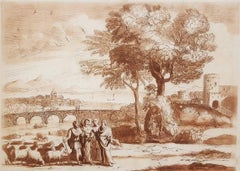Richard Earlom On Sale
Recent Sales
1770s Realist Prints and Multiples
Mezzotint
1770s Baroque Landscape Prints
Mezzotint, Etching
Richard Earlom for sale on 1stDibs
Richard Earlom was an English mezzotinter. He was born and died in London. His natural faculty for art appears to have been first called into exercise by his admiration for the lord mayor's state coach, which had just been decorated by Giovanni Battista Cipriani. Earlom tried to copy the paintings and was sent to study under Cipriani. He displayed great skill as a draughtsman, and at the same time acquired without assistance the art of mezzotint. In 1765, Earlom was employed by Alderman Boydell, a publisher and promoter of the fine arts, to make a series of drawings from the pictures at Houghton Hall and these he engraved in mezzotint. His best works are perhaps the fruit and flower pieces after the Dutch artist’s Van Os and Jan van Huysum. Among his historical and figure subjects are Agrippina, after Benjamin West; Love in Bondage, after Guido Reni; the Royal Academy, the Embassy of Hyderbeck to meet Lord Cornwallis, Colonel Mordant's Cock Fight and a Tiger Hunt, all after Johan Zoffany, and Lord Heathfield, after Sir Joshua Reynolds. Earlom also executed a series of 200 facsimiles of the drawings and sketches of Claude Lorraine, which was published in three folio volumes under the title of Liber Veritatis (1774–1819).
Finding the Right prints-works-on-paper for You
Decorating with fine art prints — whether they’re figurative prints, abstract prints or another variety — has always been a practical way of bringing a space to life as well as bringing works by an artist you love into your home.
Pursued in the 1960s and ’70s, largely by Pop artists drawn to its associations with mass production, advertising, packaging and seriality, as well as those challenging the primacy of the Abstract Expressionist brushstroke, printmaking was embraced in the 1980s by painters and conceptual artists ranging from David Salle and Elizabeth Murray to Adrian Piper and Sherrie Levine.
Printmaking is the transfer of an image from one surface to another. An artist takes a material like stone, metal, wood or wax, carves, incises, draws or otherwise marks it with an image, inks or paints it and then transfers the image to a piece of paper or other material.
Fine art prints are frequently confused with their more commercial counterparts. After all, our closest connection to the printed image is through mass-produced newspapers, magazines and books, and many people don’t realize that even though prints are editions, they start with an original image created by an artist with the intent of reproducing it in a small batch. Fine art prints are created in strictly limited editions — 20 or 30 or maybe 50 — and are always based on an image created specifically to be made into an edition.
Many people think of revered Dutch artist Rembrandt as a painter but may not know that he was a printmaker as well. His prints have been preserved in time along with the work of other celebrated printmakers such as Pablo Picasso, Salvador Dalí and Andy Warhol. These fine art prints are still highly sought after by collectors.
“It’s another tool in the artist’s toolbox, just like painting or sculpture or anything else that an artist uses in the service of mark making or expressing him- or herself,” says International Fine Print Dealers Association (IFPDA) vice president Betsy Senior, of New York’s Betsy Senior Fine Art, Inc.
Because artist’s editions tend to be more affordable and available than his or her unique works, they’re more accessible and can be a great opportunity to bring a variety of colors, textures and shapes into a space.
For tight corners, select small fine art prints as opposed to the oversized bold piece you’ll hang as a focal point in the dining area. But be careful not to choose something that is too big for your space. And feel free to lean into it if need be — not every work needs picture-hanging hooks. Leaning a larger fine art print against the wall behind a bookcase can add a stylish installation-type dynamic to your living room. (Read more about how to arrange wall art here.)
Find fine art prints for sale on 1stDibs today.
